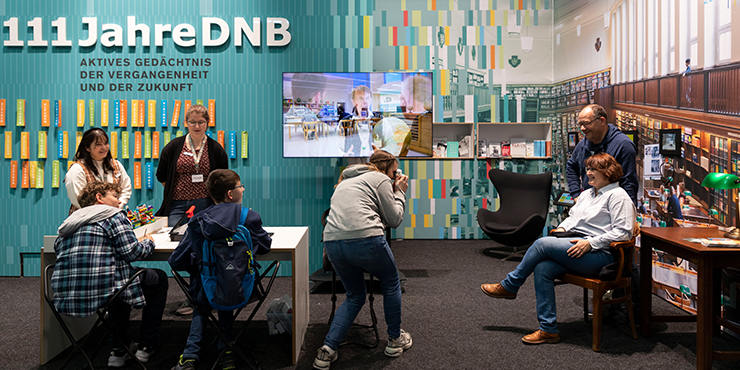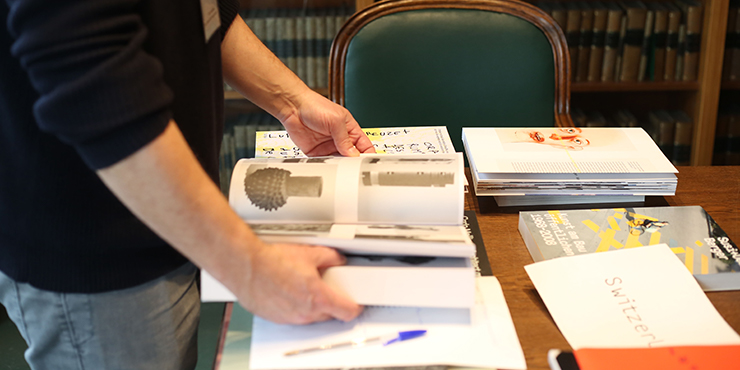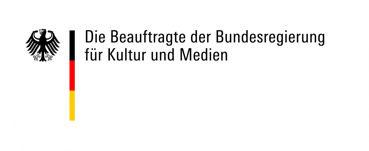Expanding our digital collections
 Photo: Stephan Jockel
Photo: Stephan Jockel
Which channels were used to distribute literature? "Das Zentralantiquariat der DDR" ("The Central Antiquarian Bookstore of the GDR")
The task of the GDR's Central Antiquarian Bookstore: to collect, process and sell antiquarian literature, most of which was scientific in nature. The Central Antiquarian Bookstore played a key role in the distribution of antiquarian literature after 1945. But what form did its commercial practices take? In the late autumn of 2022, Berlin State Library initiated a two-year research project to investigate the origins (provenance) of books traded on the antiquarian markets during the postwar decades. The German National Library is a cooperation partner.
The Zentralantiquariat (Central Antiquarian Bookstore) was established in Leipzig in 1959 as a GDR trading company. Literature was sold to institutions in the GDR, such as the Berlin State Library and the Deutsche Bücherei in Leipzig, via a right of first refusal.
In order to generate foreign currency, the Central Antiquarian Bookstore also exported large quantities of books to the – in GDR jargon – "Non-Socialist Economic System", especially to the Federal Republic of Germany, Sweden, the Netherlands and Switzerland.
The German National Library supplies important sources
The SBB is investigating the sales practices and distribution channels of the Central Antiquarian Bookstore as part of a two-year research project funded by the German Lost Art Foundation: what form did circulation and distribution processes take at that time? As a cooperative partner, the German National Library is placing an abundance of key sources at Berlin State Library's disposal: the German Museum of Books and Writing houses some 170 auction and sales catalogues and more than 1,600 offer lists issued by the Central Antiquarian Book Repository. Berlin State Library is digitising these and using full-text recognition to catalogue them as part of the project. Berlin State Library has also published a list of desiderata consisting of missing catalogues and offer lists in the hope of being able to add to the corpus of sources later on.
A closer look at critical provenances
Besides digitising sources, project participants are also conducting research into purchases made by the predecessors of Berlin State Library and by other libraries in East and West Germany from the GDR's Central Antiquarian Bookstore. The aim is to document provenances typically found among items that passed through the Antiquarian Bookstore. Particular attention is being paid to the identification of critical provenances such as Nazi loot, land reform expropriation and books left behind by so-called "Republikflüchtige" ("deserters from the Republic"). The results are being documented in Berlin State Library's digitised collections, ProvenienzWiki, and the Proveana database.
The libraries whose acquisitions are being examined include the German Museum of Books and Writing, whose purchases from the Central Antiquarian Bookstore can be identified from its accession books. In the summer of 2023, the research assistant working on the project accordingly spent three months at the German Museum of Books and Writing in Leipzig using the accession books to identify CA acquisitions procured between the 1960s and 1980s and performing autopsies to investigate their possible provenance.
Small proportion of suspicious cases
Approx. 2,050 volumes were examined in all. The provenance marks recorded during the autopsies – stamps, bookplates, autographs, dedications, old shelf marks and numbers – refer to persons and corporate entities such as universities, schools, and even castle libraries or libraries maintained by aristocratic families. These volumes were probably sent to the Central Antiquarian Bookstore for sale when libraries closed or duplicates were removed from library collections. Examination of the acquisitions occasionally flagged up cases of suspected Nazi looting or land reform expropriation, although these only make up a very small proportion in quantitative terms. These suspicious cases are now being investigated further by the DNB's provenance research expert.
Click here to access Berlin State Library's digitised holdings, ProvenienzWiki and the Proveana database.
A digital insight into history
Other sources on the history of National Socialism and exile can now be accessed in digital format, including the "Reichausbürgerungskartei", containing more than 38,000 index cards, and 900 short texts which Walter Meckauer took with him into exile in a suitcase. Even the spoken word can now be accessed digitally. The German National Library has been granted free access to the full Visual History Archive (VHA) as part of a cooperative partnership between the Exile Archive and the USC Shoah Foundation.
On 10 July 1940, the Nazis expatriated university professor and economist Fritz Neumark. This is noted in the "Reichausbürgerungskartei", which contains 38,000 records kept on index cards. Fritz Neumark found out about his expatriation in a letter from a Swiss colleague. He was already in exile in Turkey. In 1935, he took up the post of Professor of Social Hygiene and Statistics at the University of Istanbul, where he took charge of the Institute of Economics. In 1952, Neumark decided to return to Germany permanently. He later became the rector of the Goethe University in Frankfurt. He did not reassume his German citizenship until 1954 – and also kept his Turkish citizenship as a matter of precaution.
Perfidious instrument used by the National Socialists
The German Exile Archive has now made the "Reichausbürgerungskartei" accessible in digital format This collection of printed sheets was a record of persons whose German citizenship had been withdrawn between 1933 and 1941 in compliance with the Law on the Repeal of Naturalisation and Recognition of German Citizenship enacted on 14 July 1933. The German Exile Archive has now made the "Reichausbürgerungskartei" accessible in digital format. The enforced withdrawal of citizenship was a perfidious instrument used by the Nazis against their political opponents, particularly against Jews. As a result, they became stateless and their property was confiscated. Traces of expatriation are documented in many of the estates held in the Exile Archive.
The "old brown suitcase" and its story
The 900 short texts which writer and dramaturge Walter Meckauer took with him into exile are now also available in digital format and can be viewed worldwide. Meckauer left Germany in March 1933 after being warned of his impending arrest. Accompanied by his family, he emigrated via Switzerland to Positano in Italy. In 1939, they fled onwards to the south of France, returning the Switzerland in 1942 after an eventful journey.
Walter Meckauer's secretary salvaged the short texts after his precipitous flight in 1933 and took them to Switzerland in a suitcase. The "old brown suitcase", as it was called by the family, contains an extensive bundle of manuscripts, stories, reports and observations; approx. 1,000 pages in all, some of which Meckauer had already published in newspapers. The suitcase is part of the permanent exhibition “Exile. Experience and Testimona” at the Exile Archive in Frankfurt am Main, where it makes up a fixed ensemble with the texts.
Open access to more than 50,000 interviews
It is now also possible to access the spoken word in digital format as well as the written word. As part of a cooperative partnership with the USC Shoah Foundation, the German National Library has been granted free access to the full Visual History Archive (VHA), which encompasses more than 50,000 interviews. It is the world's largest collection of interviews on the Shoah and Nazi extermination policy. Persons featured in the Exile Archive, including German scholar and librarian Kurt Salomon Maier, writer Anja Lundholm, political scientist John Stoessinger, cabaret artist and author Rolf Kralovitz and trade unionist Ernesto Kroch, also told their stories to interviewers.
Up-to-the-minute: faster access to licence data
The EZB (Electronic Journal Library) and ZDB (German Union Catalogue of Serials) have worked in close cooperation for more than two decades. The ZDB is jointly operated by Berlin State Library and the German National Library, which also share responsibility for its ongoing development, while the EZB is based at Regensburg University Library. Ever since the beginning of their cooperation, the EZB and ZDB have been offering a range of services such as the EZB-ZDB Data Service, which was modernised in 2023.
Institutions can have the EZB-ZDB Data Service activated if they record their licence data in the EZB. The licence data provide information on which periodicals or volumes of periodicals are licensed and therefore available at the respective institution. The data generated by the corresponding institution in the EZB are then imported into the ZDB – optionally with additional records from open access periodicals – so that they can be viewed and researched in the ZDB catalogue. The established data services and interfaces of the German Union Catalogue of Serials are then used to make the data available to the library networks for import into their network catalogues and library systems.
Until now, the EZB has delivered data in a proprietary XML format for weekly import into the ZDB. The data were imported with due consideration of the weekly volume limit agreed with the library networks. This limit guarantees that the volume of data in each ZDB delivery can be processed by the importing systems.
Automation for the latest information
The process used for the EZB-ZDB Data Service was converted with effect from 1 June 2023 and is now more automated. The EZB now delivers the licence data through an OAI interface every day using the standard library format MARC21-xml. As far as the volume limit permits, the DNB queries the interface on a daily basis and imports the modified data from the previous day. This means that the licence data provided by the EZB is more up-to-date than before. The automation of this process also activates the verification mechanisms implemented in the cataloguing system, thus enhancing the quality of the imported data.
Increasing the volume limit to ensure that data are up-to-date
However, the holdings data generated and updated in the EZB and ZDB cooperative systems on a daily basis have now reached a considerable volume. Until now, the maximum limit on data volume has slowed data imports and deliveries to the receiving system. Since February 2024, the maximum limit has been raised incrementally to ensure that the systems can update or synchronise promptly. The target: to raise the upper limit for volumes of ZDB holdings data from a maximum of 200,000 a week to a maximum of 1,000,000 a week in 2024.
This increase is the first step towards a general expansion – and ideally abolition – of maximum limits for data exchange. The aim is to ensure that the EZB-ZDB Data Service continues to enjoy the advantages of the new process – the possibility to update EZB data on a daily basis – during licensing phases. A very large volume of modified data is generated in the EZB during such phases as a result of contractual amendments.
Click here to go to the article on the second service offered jointly by the EZB and ZBD – the JOP service.
Security when using digital holdings – a neverending IT task
E-books, articles, issues of e-journals, audio books or downloadable music tracks: the German National Library's collection mandate also encompasses digital objects, known as "non-physical media works". At the German National Library, these also include digital objects generated for purposes of catalogue enrichment, such as tables of contents from printed books and entire digital objects generated to facilitate collection preservation. In 2023, considerable progress was made with the ongoing task of renewing the IT infrastructure for collecting non-physical media works.
Here an agile, step-by-step process has proven invaluable. In this context, "agile" and "step-by-step" mainly mean that the German National Library can react flexibly to the respective themes and requirements that arise as the technology is developed rather than having to consider everything all at once. The process will bring about significant improvements in 2024, particularly with regard to the reusability and robustness of the developed software and processes.
In 2023, attention focused on the development of two processes in particular. Firstly, work progressed on the import of catalogue enrichment data such as tables of contents from the project “Catalogue enrichment 1945-2012”. Secondly, a brand new process for the functional import of non-physical music objects using the widely used metadata format DDEX ERN 4.3 was developed for the music industry. Both of these processes have reached such an advanced stage that they will be ready to go live in 2024.
A major goal in view
Important foundations have been laid, particularly for the realisation of the import function for the new object type "digital music". These are vital for the modernisation of all functions required for the import of non-physical media works. The same applies to object types that have already been successfully imported using the old infrastructure.
The modernisation of the overall infrastructure remains a major task which the DNB will continue to work on in the medium term. The goal: the infrastructure as a whole will eventually contain all the transaction processes associated with the collection of non-physical media – and culminate in a holistic, flexibly reusable process landscape for this large part of the German National Library's holdings.
Last changes:
04.06.2024





